1. INTRODUCTION
- To maintain homeostasis, the functions of the organs/organ systems in our body must be
- This coordination and integration of all the activities of the organs is provided by neural system and endocrine system jointly (neuroendocrine system).
- The neural system provides a point to point rapid coordination among organs. This response is rapid but short lived. For example: The nerve impulse causes the skeletal muscle to respond only in milliseconds.
- As all the cells of the body are not innervated by neurons, the cellular functions are continuously coordinated and integrated by the endocrine system through hormones. The response of target tissue to the action of hormone requires seconds or minutes or even more.
2. ENDOCRINE GLANDS AND HORMONES
- The study of endocrine glands and hormones is called endocrinology.
- The name hormone was coined by H. Starling.
- Hormones are also known as ‘chemical messengers’
- The first hormone discovered is secretin.
- The endocrine glands are called ductless glands because they lack ducts.
- Hormones are defined as non-nutrient chemicals.
- They act as intercellular messengers and are produced in trace amounts.
- Hormones are short lived and they are degraded by tissues and excreted through bile and urine
Chemically hormones fall into three classes
1. Amino hormones : These are derivatives of a single amino acid.
- The examples for this class are
a) Catecholamines (epinephrine and norepinephrine) and thyroxine, as derivatives of ‘tyrosine’ and
b) Melatonin, a derivative of ‘tryptophan’.
2. Peptide and Protein hormones are polymers of amino acids.
- Small peptide hormones (3 to 49 amino acids) include ADH, oxytocin etc.
- The peptides that are formed by numerous amino acids (50 to 200) are referred to as protein horones.
- Hormones of the anterior pituitary, pancreas, parathyroids etc
- The more complex protein hormones, with carbohydrates side chains, namely glyco-proteins include FSH, TSH, LH etc
3. Steroid hormones
- Steroid hormones, the derivatives of cholesterol, include hormones such as aldosterone, testosterone, estrogens and progesterone
- The widely studied prostaglandins are derivatives of eicosanoids (a large group of molecules derived from the ‘essential fatty acids’ such as the omega-3 and omega-6 fatty acids).
- On the basis of their solubility hormones are classified into water- soluble and Lipid -soluble hormones.
- Water- soluble hormones: These are the hormones that circulate through watery plasma of blood in a “ free form”. They include amine hormones, peptide and protein hormones and eicosanoid hormones.
- Lipid soluble hormones: These hormones are insoluble in water. They are found to plasma proteins and circulate in blood. They include steroid and thyroid hormones.
3. HUMAN ENDOCRINE SYSTEM
- The endocrine system constitute endocrine glands and hormone producing diffused tissues/cells located in different parts of the body.
- The endocrine system consists of organised endocrine bodies such as pituitary, pineal, thyroid, adrenal, pancreas, parathyroid, thymus and gonads.
- In addition, some other organs, eg: liver, heart, kidney, gastrointestinal tract also produce hormones.
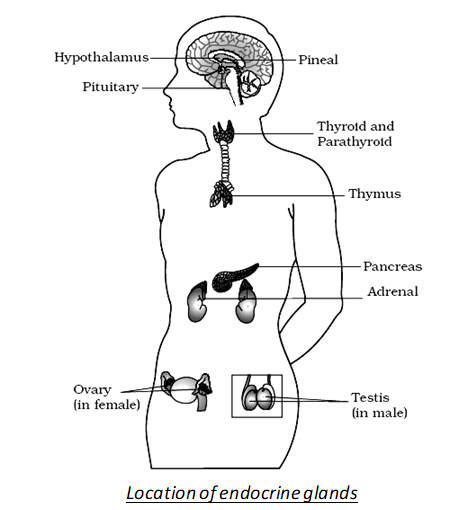
4. THE HYPOTHALAMUS (MASTER CONTROL CENTRE)
- The hypothalmus is located below the thalamus, constituting the floor of the diencephalon
- It connects the neural and endocrine system as it is closely tied to pituitary gland.
- Hypothalamus is the basal part of diencephalon.
- It contains several groups of neurosecretory cells called nuclei. They produce two types of hormones namely
1) The releasing hormones and
2) the inhibiting hormones. - The releasing hormones stimulate the secretion of pituitary hormones. For example: The synthesis and release of growth hormone from the pituitary is stimulated by the releasing hormone (GHRH / somatocrinin), secreted by hypothalamus.
- The inhibiting hormones inhibit the secretion of pituitary hormones.
- For example, somatostatin/GHIH from hypothalamus inhibits the release of growth hormone (somatotropin) from the pituitary.
- These hormones secreted by the hypothalamic neurons pass through the axons and released into the hypophysial portal system through which they reach the anterior pituitary (adenohypophysis).
- The posterior pituitary (neurohypophysis) is under the direct neural regulation of hypothalamus.
- Adenohypophysis is under hormonal regulation of hypothalamus.
5. THE PITUITARY GLAND
- It is a pea sized (1.3 cm) gland that lies in sella turcica of the sphenoid
- It is attached to hypothalamus via infundibulum.
- Anatomically it is divided into an adenohypophysis and a
- Adenohypophysis consists of Pars distalis (anterior pituitary) and pars intermedia.
- Adenohypophysis develops as outgrowth of ectoderm (Rathke’s pouch) from the roof of the buccal cavity (stomodaeum).
- Anterior pituitary (pars distalis) secretes six protein hormones where as pars intermedia secretes one protein hormone called melanocyte stimulation hormone (MSH).
- In humans pars intermedia is almost merged with pars distalis.
- Neurohypophysis (pars nervosa) also known as posterior pituitary develops as an ectodermal outgrowth of hypothalamus (floor of diencephalon).
- It stores and releases two hormones called oxytocin and vasopressin, which are actually synthesized by the hypothalamus and transported axonally to the neurohypophysis.
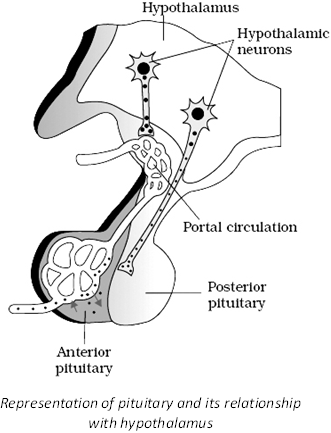
Hormones of anterior pituitary
- The anterior pituitary secretes six protein hormones out of which five are tropic hormone (except GH).
1) Growth hormone (GH) or somatotropin: - hGH stimulate hepatocytes, cells of cartilage, bone, striated muscle etc., to produce ‘IGFs’(insulin like growth factors).
- This hormone stimulates growth and development of all the tissues by accelerating protein synthesis and decreasing catabolism of proteins.
- Growth hormone releasing hormone (GHRH) – Somatocrinin
- Growth hormone inhibiting hormone (GHIH) – Somatostatin.
2) Prolactin (PRL)
It regulates the growth of mammary glands during pregnancy and initiates production of milk after child birth.
- It helps to maintaining of the corpus luteum
- Its function is not known in males. It’s release is inhibited by prolactin inhibiting hormone or dopamine.
- It helps to sustain pregnancy
3) Thyroid stimulation hormone (TSH):
- Stimulates the synthesis and secretion of thyroid hormones from the thyroid gland.
4) Adrenocorticotropic hormone
- (ACTH): Stimulates the synthesis and secretion of steroid hormones from the adrenal cortex.
5) Gonadotropins: Luteinizing hormone
- (LH) and Follicle stimulating hormone (FSH) are collectively referred to as gonadotropins as they stimulate gonadal activity.
- In males LH or interstitial cell stimulating hormone (ICSH) stimulates the interstitial cells of Leydig in the testis to secrete testosterones in males, FSH and testosterones regulate spermatogenesis.
- In females FSH stimulates growth and development of ovarians follicles.
- In females, LH stimulates ovulation and maintains corpus luteum.
Hormone of pars intermedia
- It secretes a single protein hormone called melanocyte stimulating hormone (MSH). It acts on melanocytes and regulates pigmentation of the skin. In humans the pars intermedia is merged with pars distalis.
- Hormones of neurohypophysis: It stores and releases two peptide
1) Oxytocin: It causes uterine contraction during child birth and milk ejection after delivery. It also causes general contraction of smooth muscles and stimulates adenohypophysis to secrete LTH. It’s function is not clearly known in males and non-pregnant females.
2) Vasopressin: It stimulates the reabsorption of water and electrolytes by the distal tubules of the kidney and reduces the loss of water through urine (diuresis). Hence, it is also called antidiuretic hormone (ADH). It enhances atrial blood pressure by causing contraction of arterioles
6. THE PINEAL GLAND (EPIPHYSIS CEREBRI)
- It is a small gland locates on the dorsal side of the third ventricle of the brain.
- It secretes a amine hormone melatonin, derived from the aminoacid tryptophan. It regulates diurnal rhythm of the body (eg: Sleep-wake cycle). It also influences metabolism, body temperature, pigmentation (makes the skin pale in amphibians), the menstrual cycle as well as our defense capability. It is antagonistic to MSH.
- Secretion of melatonin is more in darkness (night time).
- Recent studies indicate that the main target of melatonin is the suprachiasmatic nucleus (SCN) of the hypothalamus which acts as the “Biological clock” in humans. hormones derived from tyrosine, [e.g. Tetraiodothyronine T4 or thyroxine and triiodo thyronine [T3]. These are iodinated forms of tyrosine.
7. THYROID GLAND
- It is endodermal in origin.
- This is highly vascular and the largest endocrine gland located on either side of the trachea in the neck region. It consists of two lobes connected with a thin flap of connective tissue called isthmus. Each lobe consists of follicles and stromal tissue. The follicular cells secrete two amine
- These hormones increase basal metabolic rate (BMR), support RBC formation, controls metabolism of carbohydrates, proteins and fats, maintains water and electrolyte balance, affects growth and they are essential for metamorphosis in amphibians parafollicular cells of thyroid gland secrete a protein hormone called thyrocalcitonin (TCT) or calcitonin.
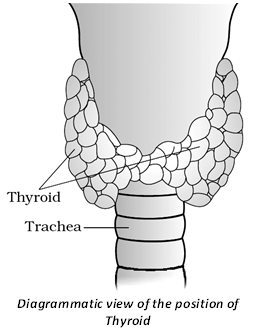
8. PARATHYROID GLANDS
- There are four parathyroid glands partially embedded in thyroid lobes dorsally. They are endodermal in origin. They secrete a peptide hormone called parathyroid hormone (PTH) . The secretion of PTH is regulated by the circulating levels of calcium ions.
- PTH is a hypercalcemic hormone that increases the blood Ca2 . It stimulates bone resorption by increasing the activity of osteoclasts. It stimulates reabsorption of Ca2 by the renal tubules. It increases
- Ca2 absorption from the digested food by promoting the formation of active form of vitamin D. It pramotes the activation of vitamin D into its active form the hormone called calcitriol
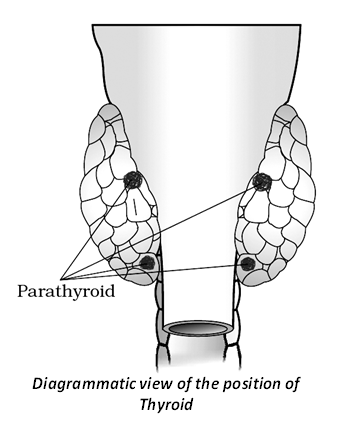
9. THYMUS GLAND
- It is a lobular structure located on the dorsal side of the heart and the aorta. Underneath the breast bone It is degenerated in the old individuals (after the age of 25 years) resulting in the decreased production of thymosin. It is partly endocrine and party lymphoid.
- This gland secretes the peptide hormone called Thymosins promotes differentiation of T-lymphocytes, which provide cell-mediated immunity and also promote production of antibodies, which provide humoral immunity.
19. ADRENAL GLANDS (OR) SUPRARENAL GLANDS
- There is a pair of adrenal glands, one at the anterior part of each kidney. The gland is differentiated into an outer cortex that develops from mesoderm and a central medulla that develops from ectoderm.
- The adrenal cortex can be subdivided into three layers, called zonaglomerulosa (outer most layer), zona fasciculata (middle layer), and zona reticularis (inner layer).
- The adrenal cortex secretes many hormones collectively called These are divided into 3 groups viz, mineralocorticoids, glucocorticoids and sex corticoids.
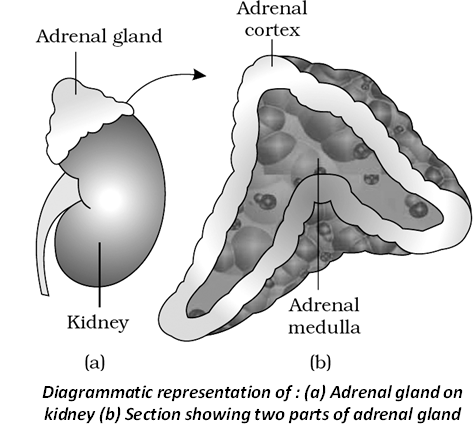
1) Mineralocorticoids: They regulate the balance of water and electrolytes in our body. The main mineralocorticid is aldosterone. It stimulates the reabsorption of Na and water and excretion of K and phosphate ions in the renal tubules and thus helps in the maintenance of electrolytes, body fluid volume, osmatic pressure and blood pressure. Mineralocorticoids are secreted by zona glomerulosa.
2) Glucocorticoids: They are involved in carbohydrate metabolism. The main glucocorticoid is cortisol (stress combathormones). Glucocorticoids stimulate,gluconeogenesis, lipolysis and proteolysis and inhibit cellular uptake and utilization of aminoacids. They have anti-inflammatory effect and suppress immune response.
- Cortisol stimulates the production of RBC.
- Cortisol maintains cardio-vascular system as well as kidney functions.
- Glucocorticoids are secreted by zona fasciculota.
3) Androgenic steroids: They are secreted in small amounts. They play a role in the growth of axial hair, pubic hair and facial hair during puberty. They are secreted from and zona reticularis.
- Hormones of adrenal medulla. Adrenal medulla secretes two hormones called adrenaline or epinephrine and noradrenaline or norepinephrine which are commonly called catecholamines.
- These hormones are called emergency hormones or hormones of fight or flight because they are secreted in response to stress and during emergency conditions.
- The functions of these hormones are closely allied to those of the sympathetic part of autonomic nervous system.
- These hormones increase alertness, pupilary dilation, piloerrection (raising of hair) sweating, increase the heart beat, the strength of heart contraction, rate of respiration, stimulate the breakdown of glycogen lipids and proteins.
- Thus they increase blood levels of glucose.
11. PANCREAS
- Pancreas acts as both as an exocrine and endocrine gland (mixed gland) or heterocrine gland. The exocrine part of pancreas consists of ‘acini’ that produce digestive enzymes. The endocrine part of pancreas consists of “Islets of Langerhans” (1 to 2 million Islets of Langerhans in normal human pancreas). Each pancreatic islet contains 4 types of cells. They are alpha cells beta cells.
Hormones of Pancreas
1) Glucagon: It is a peptide hormone secreted by alpha cells It is a hyperglycemic hormone that stimulates glycogenolysis and gluconeogenesis in hepatocytes. Glucagon reduces the cellular glucose uptake and utilization.
2) Insulin: It is a peptide hormone secreted by beta cells. It is a hypoglycemic hormone which stimulates glycogenesis in the target cells.
It enhances cellular glucose uptake and utilization. It accelerates lipogenesis (synthesis of fatty acids) and protein synthesis and slows down glycogenolysis and gluconeogenesis. Thus it maintains homeostasis of blood glucose and promotes other metabolic activities that are anabolic.
12. GONADS
- Testis: Testis performs the dual functions as primary sex organ as well as an endocrine gland. Interstitial cells of Leyding which are present in the intertubular spaces produce a group of hormones called androgens mainly
- Sertoli cells secrete inhibin that inhibits sperm formation.
- Androgens are responsible for the development of penis, scrotum, prostate gland, epididymis, vas deferens, seminal vesicles, urethra etc., These hormones stimulate, muscular growth, growth of facial and axillary hair, aggressiveness, low pitch of voice etc., They influence male sexual behavior and produce anabolic effects on protein and carbohydrate metabolism. They stimulate spermatogenesis.
Ovary
- It performs dual functions as primary sex organ as well as endocrine gland. Ovary consists of ovarian follicles and stromal tissues. It produces two groups of steroid hormones called estrogens and progesterone.
- Estrogen or estradiol: It is mainly secreted by the growing ovarian follicles. Estrogens are responsible for the development of female secondary sex organs, ovarian follicles, female secondary sex characters (eg. high pitch of voice etc.,) mammary gland development. Estrogens also regulate female sexual behaviour.
- Progesterone: It is secreted by a structure called corpus luteum which is formed from the ruptured graffian follicle after ovulation.
- Progesterone prepares uterus for pregnancy, inhibits ovulation and menstrual cycle during
- It acts on mammary glands and stimulates the formation of alveoli (sac like structures which store milk) and milk secretion.
13. HORMONES OF HEART, KIDNEY AND GASTROINTESTINAL TRACT
1) Atrial natriuretic factor (ANF): It is a peptide hormone secreted by atrial wall of the heart. It decreases blood pressure by causing the dilation of blood vessels.
2) Erythropoietin: It is a peptide hormone secreted by the Juxtaglomerular cells of the kidney,. It stimulates erythropoiesis (formation of RBC).
3) A hormone called renin secreted by the kidneys helps in erythropoiesis.
4) Hormones of gastro intestinal tract:
The endocrine cells present in different parts of gastrointestinal tract secrete four major peptide hormones, namely gastrin, secretin, cholecystokinin (CCK) and gastric inhibitory peptide (GIP).
a) Gastrin: It stimulates the gastric glands to secrete hydrochloric acid and pepsinogen.
b) Secretin: It stimulates the exocrine pancreas to secrete water and bicarbonate ions.
c) Cholecystokinin (CCK): It is produced in duodenum in response to fats in chyme. It acts on pancreas and gall bladder and stimulates the secretion of pancreatic enzymes and release of bile juice, respectively.
d) Gastric inhibitor peptide: It inhibits gastric secretion and motility.
14. MECHANISM OF HORMONE ACTION
- Hormones affect only specific target cells by binding to specific proteins called hormone receptors located in the target cells only. Some hormones (e.g. growth hormone and thyroxine) affect many cells of different types as all of these cells possess receptors for these hormones. So cells may not be specific to a particular hormone. But receptors are specific because each receptor is specific to one hormone only.
- Hormone receptors are of two types.
1. Membrane bound receptors
2. Intracellular receptors.
1. Membrane bound receptors: They are present on the cell membrane of the target cells. Water soluble hormones (protein hormones, peptide hormones and catecholamines) bind to the membrane bound receptors. This causes the generation of second messengers (eg., Cyclic AMP, IP3 , Ca etc) which intern activate a cascade of enzymes and regulate cellular metabolism.
(C-AMP = Cyclic adenosine monophosphate).
An enzyme called adenylate cyclase removes two phosphates from ATP and circularises it, forming C-AMP).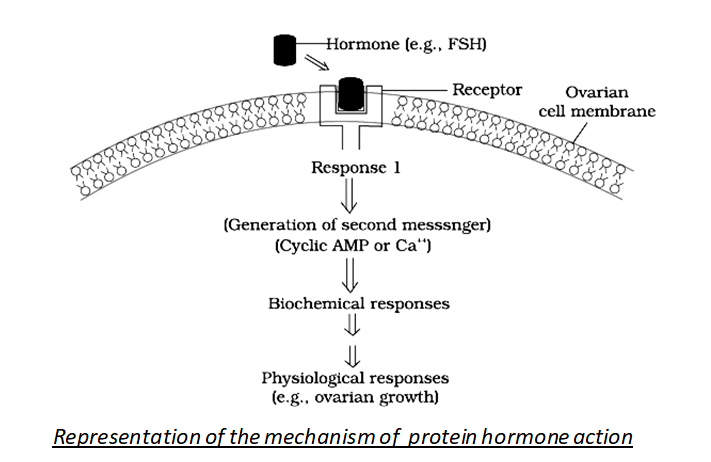
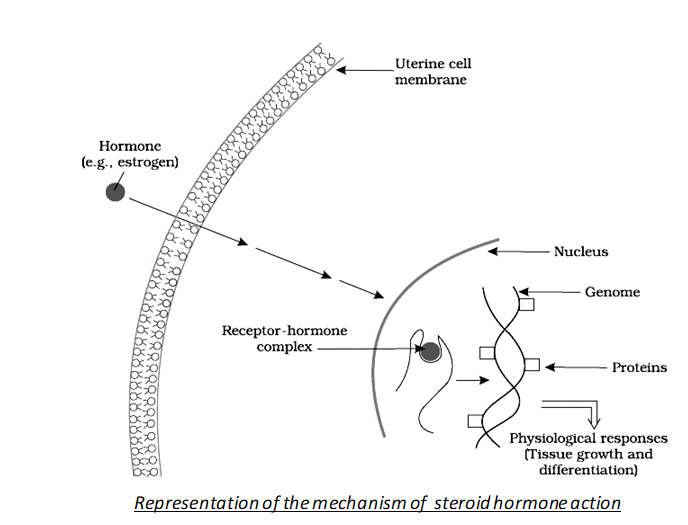
2. Intracellular receptors: They are mostly nuclear receptors. Lipid soluble hormones
(eg., steroid hormones, iodothynonines, etc) binds to intracellular receptors and forms a hormone-receptor complex. The activated hormone receptor complex binds to a particular DNA sequence and either activates or repress a specific gene.
3. The cellular response to a steroid hormone or a thyroid hormone is directly proportional to the number of hormone-receptor complexes that are formed. But the response of a hormone operating through the second messenger is greatly amplified.
15. HUMAN HORMONAL DISORDERS DUE TO HYPO AND HYPER SECRETIONS PITUITARY GLAND DISORDERS
a) Gigantism: Hypersecretion of growth stimulating hormone (or) somatotropin during childhood prior to puberty leads to gigantism.
It is characterized by an abnormal increase in the length of long bones. The person grows very tall, but body proportions are about normal.
b) Acromegaly: Hypersecretion of growth stimulating hormone (ior) somatotropin during adulthood results in an abnormality called acromegaly.
It is characterized by enlargement of bones of the jaw, hand and feet, thickened nose, lips, eyelids and wide finger tips and ‘gorilla like appearance of the person affected.
c) Pituitary dwarfism: Hyposecretion of growth stimulating hormone (or) somatotropin during childhood retards growth, resulting in a pituitary dwarf / midget. The proportions are child like. At adult age they may attain a height of 3 or 4 feet.
There are sexually and intellectually normal
d) Diabetes Insipidus : Hyposecretion of vasopressin causes diabetes insipidus, leading to excessive excretion of dilute urine (about 20 liters a day). This causes dehydration, extreme thirst and Alcohol inhibits secretion of ADH. So drinking alcohol may cause copius urination.
Disorders of thyroid gland
- Hypothyroidism: Insufficient secretion of T3 and T4 causes cretinism in children and myxodema in adults. Cretins are characterised by stunted growth, low intelligence quotient, abnormal skin, deaf-mutism and sterile.
- The features of cretinism resemble the traits of Down’s syndrome (Mongolid idiocy).

- A hallmark of myxoedema is oedema that causes the facial tissue to look puffy.
- The hypothyroidism caused due to inadequate dietary iodine intake results in the enlargement of thyroid gland, commonly called simple goitre.
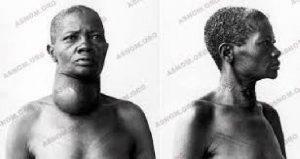
- Hyperthyroidism: It is due to cancer of thyroid gland or due to development of nodules of the thyroid gland
- The most common form of hyperthyroidism is Graves’s disease which is an autoimmune disorder in which the person produces antibodies that mimic the action of TSH. Graves’s patients often have a peculiar oedema behind the eyes called expthalmos in addition to thyroid enlargement (goiter).
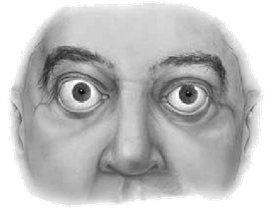
- Thyroxine is essential for metamorphosis in amphibians.
Parathyroid Disorders
- Hypoparathyroidism Multimedia
- The main cause of Hypoparathyroidism is accidental damage to the parathyroid glands or to their blood supply, during thyroid surgery.Hypoparathyroidism leads to deficiency of Ca+2 which causes neurons and muscle fibres to depolarize and produce action potentials spontaneously. This leads to tetany (sustained contraction) of skeletal muscle.
- Hyperparathyroidism
- Hyperparathyroidism is most often due to a tumour of one of the parathyroid glands.
- An elevated level of PTH causes excessive resorption of bone matrix, raising the blood levels of calcium (hypercalcemia) and phosphate.
- Disorders of pancreatic islets:
- Diabetes mellitus: It is caused due to deficiency or absence of insulin causing impaired carbohydrate, fat and protein metabolism. It is associated with glucosuria or glycosuria (loss of glucose in urine), Polyuria (excessive urine production), Polydipsia (excessive thirst) and polyphagia (excessive eating) and formation of harmful compounds known as ketone bodies due to increased oxidation of fats (Acidosis).
- Hyper Insulinism: Hyper secretion of insulin leads to decreased level of glucose in the blood (hypoglycemia) resulting in insulin shock. It is characterized by anxiety, sweating, tremorr, increased heart rate, hunger & weakness.
- Adrenal glands disorders
a) Cushing’s syndrome: It is caused due to the hypersecretion of glucocorticoids (cortisol). - It is characterized by protein catabolism and redistribution of body fats, resulting in spindly arms and legs accompanied by a rounded ‘moon face’, ‘buffalo hump’ on the back, and pendulus (hanging) abdomen. Excessive gluconeogenesis causes hyperglycemia and glycosuria.
b) Addison’s disease: This is caused due to hyposecretion of all adrenal cortex hormones. - The outstanding effects of this disease are hypoglycaemia, dehydration, increased pigmentation of the skin (bronzed appearance), hypotension, decreased cardiac output, arrhythmias, mental confusion, menstrual disturbances, elevated potassium and decreased sodium in the blood.








